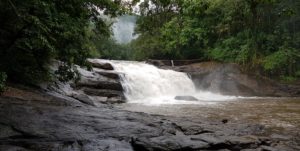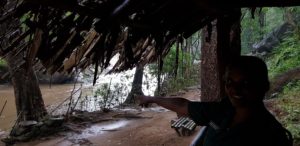Gushing waters froth stories. When set amidst lush landscapes, the viridian violence can give rise to some very haunting ones. Sarojini Omanakuttan remembers a few with moist eyes, though not exactly a shudder – toughened by the wildness of office, nothing is shook enough for her. She pointed nonchalantly to a spot outside the wayside shed where she sat keeping an eye on visitors, guiding some and sharing stories with the solivagant.
“It was exactly three years and three days ago when the engineering student drowned over there.”
The spot she pointed out was on the other side of a barbed wire fence – put in place after the student’s death – right next to a solid trunk tree. While water spun and whorled all around, the area she marked out hardly stirred – like a deaf mule in a busy marketplace. As she explained various undercurrent patterns that exist along the seven-step waterfalls, I realised that the calm was more Lecter-like.
Vana Samrakshana Samithi (VSS)
The Ministry of Environment and Forests, Government of India, through its National Forest Policy of 1988 envisages involvement of people in the development, protection and management of forests. The Policy also issued guidelines for involving village communities and voluntary agencies in the regeneration of degraded forest lands. Participatory Forest Management, PFM, is a management tool implemented in 1998 with the intent to protect and manage the non-wood forest resources in a sustainable manner with active participation of forest-dependent communities. The VSS is a grassroot level organisation that comes under PFM where forest-dependent families and members participate in planning and implementation of various forestry and community development programmes.
Sarojini Omanakuttan is a VSS guide in Thommankuthu waterfalls. The waterfalls itself doesn’t qualify as a ‘must-see’ destination but sits atop the second-must list. Unlike its more famous neighbours Athirapally and Attukad, it does not fall from stunning heights or cascade copiously. But, like them, it accords a quick tuck away into a verdant pocket. If you work in Delhi like me, or in any other highly polluted city, you can actually see the looming green canopies pump clean, breathable air. More tangibly, this is not very far from Cochin airport. It was the first weekend after the worst flooding of the century which left over 350 dead and at least a million homeless. The famous crystal clear water of the Kannadiyar (meaning ‘mirror-like river’) ran mucky.
“Besides the monsoon, this is because of the debris flow that pounded surrounding areas,” Sarojini explained.
Spotting a debris flow – Sarojini tells how
While flood deaths are attributed to rising water levels, sudden surges in fatalities are caused by landslides and resulting debris flows. Debris flows are calamitous outcomes of incessant, heavy monsoons where water-saturated soil and rocks break off from mountainsides, rush down streams leaving total annihilation in their wake. High sediment concentrations and mobility add to their destructive capabilities. There are YouTube videos from the recent floods which show how fearsome they can be. Sarojini, 58, has been living near the forest all her life. From her 20 years as guide with the VSS and an equal number of years before that attached to various forest protection activities, she has seen several landslides and its various manifestations in the Thommankuthu waters. Here she shares some pointers on how to spot a landslide – when you are frolicking in the water.
- You can hear a thunderclap-like sound, somewhat blunter.
- The water level around you will rise – keep a tab as you wade into water bodies during the monsoon season.
- The water will slowly begin to get muddy – keep an eye on the water upstream.
- Scoot immediately and make for the highest ground preferably with something to hold on to.
The entry ticket for a video camera was prohibitively high at Rs 2500, so I decided to get one just for myself (Rs 20) and a still camera (Rs 50). As luck would have it, as soon as I placed my drone camera back in the car, it started to rain. The path inside was rock-paved which made it traversable. Serenading it from the other side of a tracking barbed wire was a raging Kannadiyar – its brownish water a far cry from what it is during summertime. Most of the thick-limbed flora was identified by their mouthful, unpronounceable Latin names. A father was actually reading them out to a little girl, who, surprisingly, appeared genuinely interested. Literate was probably in our DNA.
As it began to really come down, we took shelter inside the first waiting shed along the way. It was here that I met Sarojini. She was assiduously trying to keep a fire going with the driftwood collected from the flowing water. Everyone huddled around it gratefully. But the wood was damp making it spew smoke too which teared the eyes of those who burrowed too close to the fire – the botanically inclined father included.
“The wood is wet,” he pointed out, solemnly.
Firelines and beginnings
It was in 1977 the tribal communities residing inside the forest area were forcibly thrown out. They all returned in 1982 spurring a second round of eviction. Through all these events, Sarojini was involved in various forest conservation activities along with forest officers and wardens. Her speciality was in creation of firelines. A fireline or firebreak is a strip of land that has been created by plowing, clearing or controlled burning, in order to arrest the spread of forest fires. A process that is tedious as well as a health hazard, it can sometimes pose serious threats to personal safety as well. Sarojini continued undaunted. Her diligence and sincerity got her inducted into the VSS that was set up in 1998. In 2003 when suggestions were invited to develop new tourism destinations, Sarojini rooted for Thommankuthu.
“The then DFO Sasi sir trusted my instincts and gave the go-ahead,” she remembers.
That Thommankuthu was selected over at least half a dozen other potential attractions show the goodwill and clout she enjoyed in the higher offices. But the recognition marked only the beginning of real work.
“There were shards of glass from broken liquor bottles everywhere. We not only collected all these by hand, but buried them in a deep pit so that the animals didn’t get hurt.”
Once the rains abated, everybody took off in a huff. While most of us headed on towards the starting point of the waterfalls, a newly married couple started back obviously with better things on their mind. Glistening roots and vines criss-crossed the path, like trees on a walk, holding hands. Some boulders had rolled in from higher ground, taking a breather while waiting for the next heave which would land them in the water. There was a fibre and concrete bridge across a small cataract, which, with its oval shape looked like it was salvaged from a romantic soap set. Understandably, it was a selfie hotspot. The tree tower along the way had been marked off-bounds as the wood had become excessively soggy.
“It can actually take up to three people in one go,” Sarojini had told me earlier. “But chances are that everybody in a group will want to go up together.”
This innate reluctance of tourists to listen to forest guides, probably deafened by delight and numbed by alcohol, has resulted in many deaths. Sarojini remembers an incident from not many years ago. An all-male party to celebrate the marriage of a friend. The new groom himself had passed out. The party continued to frolic in the water after Sarojini agreed to keep an eye on him; his brother-in-law had left his number with her to call as soon as he woke up. When he did finally from his soaked slumber, they tried the number which remained unanswered. Together they set out to find the brother-in-law. When they zeroed in on the spot where the rest of the party purportedly saw him last, Sarojini espied some tiny bubbles rising up. She had to bodily restrain the just-wakened weak-sauce from jumping in to attempt a rescue.
“It turned out that my suspicions were correct,” she said. “The water at that particular spot was over two men deep. Why the bubbles were small.” Had she allowed the groom to jump, he would’ve been dead too.
It took several hours of excruciating work by the fire force to extricate the dead reveller.
History and hearsay – all in a name
Like every name that has caught public fancy, there are many theories regarding the origin of the name Thommankuthu. Thommen is old Kerala for Thomas. Sarojini herself gave me a lowdown: Thommen, of course, was a tribal who lived in these parts. The waterfall was named after him following his death from (1) swimming across the river during an exceptionally strong monsoon, or (2) falling from a jackfruit tree. The tree itself fell about two years ago during the peak rainy season.
“But the most plausible reason could be the Thomban Road,” she continued. The Thomban Road was the name given to the road that was planned connecting Idukki and Madurai long ago. “My grandfather was part of the team that did the initial survey.”
Buzzkill stories are taken in their stride – neither Sarojini nor her peer guides allow them to come in the way of their work or attitude. In another of her favourite work episodes, a tourist demanded refund of his ticket money. ‘What is there to see?’ He argued with the VSS guides. ‘I didn’t pay to see a bunch of trees and a stream.’ Sarojini placated him by asking him to sit down and look up and wonder at the age of the trees. And afterwards, take their photographs, show them to his children and ask them to guess.
“I told him to watch their eyes closely as wonderment grips. This way, inculcate in them the spirit of curiosity.”
The #SarojiniChallenge
What was originally 85.5 hectares of forested land continues to be so – no encroachments, no overnight resorts, no useless little museums or interpretation centres whose metamorphosis into cosy little love decks for politicians and bureaucrats is just a matter of time. This is the fruit of the unstinted efforts of these guides – who protect the forests literally from grassroots up. But, as is the norm in cases of such selflessness, the love isn’t returned. Sarojini, till she was 55, was allotted eight days of work every month @ Rs 350 per day. Today she is 58 and considers herself lucky if she gets four. There are new guys, youngsters, who are given 10 – 15 days instead.
“This is an open challenge to the DFO,” she said, keeping me in an even gaze, “pit me against any of these guys on a competition lap across these waters.”



















Hi Thanks for sharing this article with the picture. I like the Gushing water, keep it up the Good work for Travel blogs.
WOw!! This blog is very Awesome and mind blowing. thanks for sharing this attractive pictures and this blog.
This post is brilliantly written. Our eyes are trained to start from the left. Short sentence strategy and enough white space helped me a lot to enjoy your writing. I’m struggling to adopt such a style.
Thank you, Jenny.
I do not stick to one style…a sobre piece thought I’d make it an easy read.